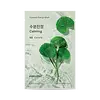What's inside
What's inside
 Key Ingredients
Key Ingredients

 Benefits
Benefits

 Concerns
Concerns

 Ingredients Side-by-side
Ingredients Side-by-side

Water
Skin ConditioningButylene Glycol
HumectantSqualane
EmollientCyclopentasiloxane
EmollientCyclohexasiloxane
EmollientTorreya Nucifera Seed Oil
EmollientSalix Alba Bark Extract
AstringentNiacinamide
SmoothingCamellia Sinensis Leaf Extract
AntimicrobialCamellia Japonica Leaf Extract
Skin ConditioningOrchid Extract
Skin ConditioningOpuntia Coccinellifera Fruit Extract
Skin ConditioningCitrus Unshiu Peel Extract
MaskingBeta-Glucan
Skin ConditioningOlea Europaea Oil Unsaponifiables
Skin ConditioningDimethicone
EmollientCetearyl Alcohol
EmollientGlyceryl Stearate
EmollientInulin Lauryl Carbamate
Emulsion StabilisingCetyl Alcohol
EmollientDi-C12-13 Alkyl Malate
EmollientOctyldodecanol
EmollientSilica
AbrasivePEG-75 Stearate
Sucrose Polystearate
EmollientHydroxyethyl Acrylate/Sodium Acryloyldimethyl Taurate Copolymer
Emulsion StabilisingPolyacrylate-13
Steareth-20
CleansingCeteth-20
CleansingPEG-100 Stearate
Polyisobutene
Glycerin
HumectantPolysorbate 20
EmulsifyingPropanediol
SolventDisodium EDTA
Phenoxyethanol
PreservativeEthylhexylglycerin
Skin ConditioningAbies Sibirica Oil
MaskingJuniperus Communis Fruit Oil
MaskingJuniperus Virginiana Oil
MaskingParfum
MaskingWater, Butylene Glycol, Squalane, Cyclopentasiloxane, Cyclohexasiloxane, Torreya Nucifera Seed Oil, Salix Alba Bark Extract, Niacinamide, Camellia Sinensis Leaf Extract, Camellia Japonica Leaf Extract, Orchid Extract, Opuntia Coccinellifera Fruit Extract, Citrus Unshiu Peel Extract, Beta-Glucan, Olea Europaea Oil Unsaponifiables, Dimethicone, Cetearyl Alcohol, Glyceryl Stearate, Inulin Lauryl Carbamate, Cetyl Alcohol, Di-C12-13 Alkyl Malate, Octyldodecanol, Silica, PEG-75 Stearate, Sucrose Polystearate, Hydroxyethyl Acrylate/Sodium Acryloyldimethyl Taurate Copolymer, Polyacrylate-13, Steareth-20, Ceteth-20, PEG-100 Stearate, Polyisobutene, Glycerin, Polysorbate 20, Propanediol, Disodium EDTA, Phenoxyethanol, Ethylhexylglycerin, Abies Sibirica Oil, Juniperus Communis Fruit Oil, Juniperus Virginiana Oil, Parfum
Water
Skin ConditioningDipropylene Glycol
HumectantButylene Glycol
Humectant1,2-Hexanediol
Skin ConditioningPolyglyceryl-10 Laurate
Skin ConditioningGlyceryl Caprylate
EmollientArginine
MaskingCarbomer
Emulsion StabilisingXanthan Gum
EmulsifyingEthylhexylglycerin
Skin ConditioningCentella Asiatica Extract
CleansingPaeonia Suffruticosa Root Extract
Skin ProtectingDisodium EDTA
Chamomilla Recutita Flower Extract
MaskingParfum
MaskingDiethylhexyl Sodium Sulfosuccinate
CleansingSodium Hyaluronate
HumectantWater, Dipropylene Glycol, Butylene Glycol, 1,2-Hexanediol, Polyglyceryl-10 Laurate, Glyceryl Caprylate, Arginine, Carbomer, Xanthan Gum, Ethylhexylglycerin, Centella Asiatica Extract, Paeonia Suffruticosa Root Extract, Disodium EDTA, Chamomilla Recutita Flower Extract, Parfum, Diethylhexyl Sodium Sulfosuccinate, Sodium Hyaluronate
 Reviews
Reviews

Ingredients Explained
These ingredients are found in both products.
Ingredients higher up in an ingredient list are typically present in a larger amount.
Butylene Glycol (or BG) is used within cosmetic products for a few different reasons:
Overall, Butylene Glycol is a safe and well-rounded ingredient that works well with other ingredients.
Though this ingredient works well with most skin types, some people with sensitive skin may experience a reaction such as allergic rashes, closed comedones, or itchiness.
Learn more about Butylene GlycolDisodium EDTA plays a role in making products more stable by aiding other preservatives.
It is a chelating agent, meaning it neutralizes metal ions that may be found in a product.
Disodium EDTA is a salt of edetic acid and is found to be safe in cosmetic ingredients.
Learn more about Disodium EDTAEthylhexylglycerin (we can't pronounce this either) is commonly used as a preservative and skin softener. It is derived from glyceryl.
You might see Ethylhexylglycerin often paired with other preservatives such as phenoxyethanol. Ethylhexylglycerin has been found to increase the effectiveness of these other preservatives.
Parfum is a catch-all term for an ingredient or more that is used to give a scent to products.
Also called "fragrance", this ingredient can be a blend of hundreds of chemicals or plant oils. This means every product with "fragrance" or "parfum" in the ingredients list is a different mixture.
For instance, Habanolide is a proprietary trade name for a specific aroma chemical. When used as a fragrance ingredient in cosmetics, most aroma chemicals fall under the broad labeling category of “FRAGRANCE” or “PARFUM” according to EU and US regulations.
The term 'parfum' or 'fragrance' is not regulated in many countries. In many cases, it is up to the brand to define this term.
For instance, many brands choose to label themselves as "fragrance-free" because they are not using synthetic fragrances. However, their products may still contain ingredients such as essential oils that are considered a fragrance by INCI standards.
One example is Calendula flower extract. Calendula is an essential oil that still imparts a scent or 'fragrance'.
Depending on the blend, the ingredients in the mixture can cause allergies and sensitivities on the skin. Some ingredients that are known EU allergens include linalool and citronellol.
Parfum can also be used to mask or cover an unpleasant scent.
The bottom line is: not all fragrances/parfum/ingredients are created equally. If you are worried about fragrances, we recommend taking a closer look at an ingredient. And of course, we always recommend speaking with a professional.
Learn more about ParfumWater. It's the most common cosmetic ingredient of all. You'll usually see it at the top of ingredient lists, meaning that it makes up the largest part of the product.
So why is it so popular? Water most often acts as a solvent - this means that it helps dissolve other ingredients into the formulation.
You'll also recognize water as that liquid we all need to stay alive. If you see this, drink a glass of water. Stay hydrated!
Learn more about Water